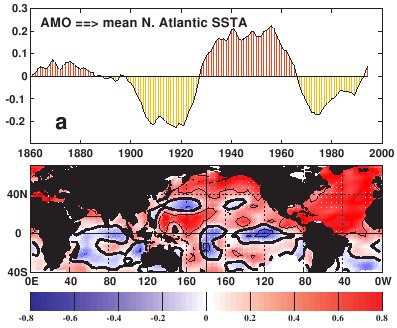Introduction
Recent research has pointed to the existence of natural climate phases, or regimes that persist on the scale of human generations (15-40 years). The climate regimes alternate under the influence of long-term sea-surface temperature oscillations in the Atlantic and Pacific Oceans. These decadal-to-multidecadal (D2M) swings in ocean temperatures have had significant impacts on air temperature, rainfall and severe storms in North America, Europe and Africa. The following figure illustrates one important D2M climate mode, the Atlantic Multidecadal Oscillation (see Q & A about the AMO)

Click here for explanation
There is also a significant D2M climate mode anchored in the Pacific Ocean, the Pacific Decadal Oscillation (PDO). Both the PDO and the AMO are associated with important climate impacts in North America. As a D2M mode switches in polarity, the associated climate regime responds and the statistics of droughts, floods, hurricanes, etc. change as well.
In this project we aim to develop ways of estimating the risk of future D2M climate regime shifts, in order to better plan for contingencies that arise when phenomena such as droughts become more (or less) frequent and the statistics of droughts, floods, hurricanes, etc. change over large land regions.

